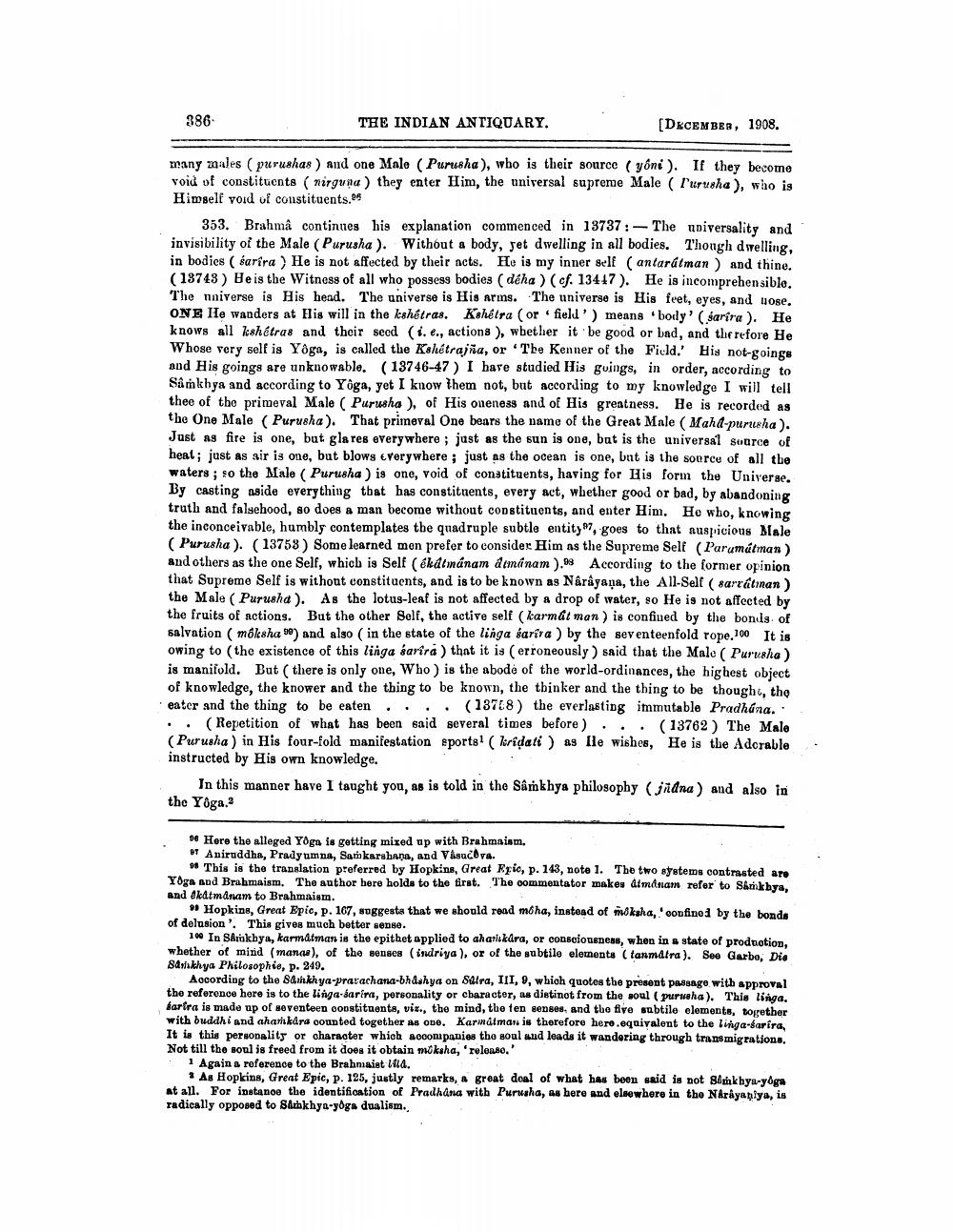________________
386
THE INDIAN ANTIQUARY.
[DECEMBER, 1908.
many znales purushas ) and one Molo (Purusha), who is their source ( yoni). If they become void of constituents ( nirguna) they enter Him, the universal supreme Male ( l'urusha ), who is Himself void of constituents.es
353. Brahmâ continues his explanation commenced in 13737 : -The universality and invisibility of the Male (Purusha ). Without a body, set dwelling in all bodies. Though dwelling, in bodies ( sarira) He is not affected by their acts. He is my inner self (antarátman) and thine. (13743) Be is the Witness of all who possess bodies (déha ) (cf. 13417). He is incomprehensible. The nniverse is His head. The universe is His Arms. The universe is His feet, eyes, and uose. ONE He wanders at His will in the kshếtras. Kshetra (or field') means 'body' sarira). He knows all kshetras and their seed (i. e., actions ), wbether it be good or bad, and therefore He Whose very self is Yoga, is called the Kshetrajña, or The Kenner of the Field. His not goinge and His goings are unknowable. (13746-47) I have studied His guings, in order, according to Samkhya and according to Yoga, yet I know them not, but according to my knowledge I will tell thee of the primeval Male ( Purusha ), of His oneness and of His greatness. He is recorded as the One Male (Purusha). That primeval One bears the name of the Great Male ( Mahd-purusha). Just as fire is one, but gla res everywhere ; jast as the sun is one, but is the universal source of heat; just as air is one, but blows everywhere ; just as the ocean is one, but is the source of all the waters; so the Male ( Purusha ) is one, void of constituents, having for His form the Universe. By casting aside everything that has constituents, every act, whether good or bad, by abandoning truth and falsehood, so does a man become without constituents, and enter Him. He who, knowing the inconceivable, humbly contemplates the quadruple subtle entity 7, goes to that suspicious Male ( Purusha ). (13758) Some learned men prefer to consider Him as the Supreme Self (Parumátman) and others as the one Self, which is Self (ékátnánam duninam). According to the former opinion that Supreme Self is without constituents, and is to be known as Narayana, the All-Self (sarvatman) the Male (Purusha ). As the lotus-leaf is not affected by a drop of water, so He is not affected by the fruits of actions. But the other Self, the active self (karmât man ) is confined by the bonds of salvation móksha 50) and also in the state of the linga sarira ) by the seventeenfold rope.100 It is owing to the existence of this linga barira) that it is (erroneously) said that the Male (Purusha) is manifold. But there is only one, Who ) is the abode of the world-ordinances, the highest object of knowledge, the knower and the thing to be known, the thinker and the thing to be thought, the eater and the thing to be eaten .. . (13718) the everlasting immutable Pradhana.. .. (Repetition of what has been said several times before) ... (13762) The Malo (Purusha) in His four-fold manifestation sports! ( loridati ) as Ile wishes, He is the Adorable instructed by His own knowledge.
In this manner have I taught you, as is told in the Sårkhya philosophy (jadna) and also in the Yoga.
96 Hore the alleged Yoga is getting mixed up with Brahmaism. " Aniruddha, Pradyumna, Sati karshana, and Vasacora.
* This is the translation preferred by Hopkins, Great Eric, p. 143, note 1. The two systems contrasted are Yoga and Brahmaism. The author hero holds to the first. The commentator makes dimanam refer to Sarikbya, and 8kdtmdnam to Brahmaiem.
Hopkins, Great Bpio, p. 107, suggests that we should read máha, instead of mkaka, confined by the bonds of delusion'. This gives much better sense.
100 In Sarokhya, karmdtman is the epithet applied to aharlikdra, or consciousness, when in a state of production, whether of mind (manga), of the senses (indriya), or of the subtilo elementa (tanmdira). See Garbo, Die Sakhya Philosophie, p. 249.
According to the Bashkhya-prarachana-bhdshya on Satra, III, 9, which quotes the present passage with approval the reference here is to the Lingamar is to the linda-karim. personality or character, as distinot from the soul ( purwaha). This Kinga
mind, the ten sepses, and the flye subtile elements, p barfra is made up of seventeen constituents, vis., the mind, the ten senses, and the five subtile elemen
er with buddhi and aharkdna oounted together as one. Karmalman is therefore hero.equivalent to the linga-farira. It is this personality or character which accompanies tho soul and leads it wandering through transmigrations, Not till the soul is freed from it does it obtain moksha, 'releaso.' Again a reference to the Brahmaista.
kina. Great Epic. p. 125. justly remarks, a great deal of what has been said is not sankhya-yoga at all. For instance the identification of Pradhana with Purusha, as here and elsewhere in the Narayaniya, is radically opposed to Sachkhya-yoga dualism..




